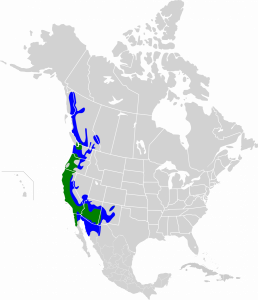Order: Caprimulgiformes
Family: Trochilidae
Genus: Calypte
Species: Calypte anna
The Anna’a Hummingbird is Evergreen State College’s smallest year round resident bird, and most common hummingbird.
Males have a brilliantly iridescent pink throat and head due to large stacks of melanosomes in their feather barbules, arranged in layers separated by keratin (Giraldo 2018). Both sexes have shining green back and sides.
The distribution of Calypte anna is know to be changing over time (Rowe 2018).
Below is a map of wintering (blue areas) and breeding+wintering (green areas) distribution of Calypte anna. (Image from Wikipedia 2011)
Below is a map of Calypte anna sightings logged on eBird. (Image from Google Maps 2019)
It is clear from these two maps that Calypte anna has been sighted outside its normal range. The range of Calypte anna has expanded over time to colder areas over time. This is though to be in part a mirroring of the increase of artificial feeder presence in those areas and increased use of exotic flowering garden plants suitable for hummingbird forage (Greig 2017). This has lead to Calypte anna becoming the only winter resident hummingbird in more and more northerly places including Western Washington (Rowe 2018) . Climate change may also be acting as a factor driving northern expansion of the range.
Calypte anna can be found in a variety of wild habitats including chaparral, coastal scrub, oak savannas, and open woodland. Urban habitats also support calytpe anna, particularly in areas where they have access to feeders and cultivated flowering plants for forage (Greig 2017). When nesting they show a preference for the lower canopy areas (Porzig 2014).
Calypte anna feed on nectar from flowers and on insects (Dunn 2017).
Calypte anna typically favor red, orang, and yellow flowers. Flower preference is determined by nectar flow and sucrose/glucose content of nectar. Unlike some other hummingbirds, Calypte anna prefer nectar sucrose/glucose levels as high as possible up to 60%, which is rare in flowers (Stiles 1976)
When it comes to insects consumed by Calypte anna the breakdown works out to around 45% Diptera , 35% Hymenoptera, 17% Hemiptera, and also around 2% spiders (Beal 1902).
Dietary selection in females with nestlings was shown to favor nectar from flowers in the morning when it is most abundant and favor insects in the afternoon when they are most abundant. This gives a more stable source of food for raising young (Carpenter 1980).
Individuals that receive more protein from their diet grow significantly brighter crown feathers emphasizing the importance of insect forage to healthy breeding plumage (Meadows 2012)
Calypte anna has a particularly complex song for a hummingbird.
Call (Cruickshank 2012)
Song (Jongsma 2012)
Song. Provided by xeno-canto, XC473410. Recorded by Bow Tyler on 4/30/2019 in Olympia, WA.
Flight display and song. Provided by xeno-canto, XC473411. Recorded by Bow Tyler on 5/7/2019 in Olympia, WA.
Calypte anna males can be quite territorial in breeding season. It has been shown that they defend their breeding territories primarily for their reproductive function and do not necessarily defend areas for their resource production (Powers 1987).
These bids can often be seen dive bombing each other, other birds, and even people to defend their breeding sites.
Beal, F. E. L., & McAtee, W. L. (1902). Food of some well-known birds of forest, farm, and garden (No. 506). US Department of Agriculture
Carpenter, F. L., & Castronova, J. L. (1980). Maternal diet selectivity in Calypte anna. American Midland Naturalist, 175-179
Dunn, J. L., & Alderfer, J. (2017). Field guide to the birds of North America. National Geographic Books
Eberhard, J. R., & Ewald, P. W. (1994). Food availability, intrusion pressure and territory size: An experimental study of Annas hummingbirds (Calypte anna). Behavioral Ecology and Sociobiology,34(1), 11-18. doi:10.1007/bf00175453
Giraldo, M. A., Parra, J. L., & Stavenga, D. G. (2018). Iridescent colouration of male Anna’s hummingbird (Calypte anna) caused by multilayered barbules. Journal of Comparative Physiology A, 204(12), 965-975
Godoy, L. A., Dalbeck, L. S., Tell, L. A., Woods, L. W., Colwell, R. R., Robinson, B., … & Ernest, H. B. (2013). Characterization of avian poxvirus in Anna’s hummingbird (Calypte anna) in California, USA. Journal of wildlife diseases, 49(4), 978-985
Greig, E. I., Wood, E. M., & Bonter, D. N. (2017). Winter range expansion of a hummingbird is associated with urbanization and supplementary feeding. Proceedings of the Royal Society B: Biological Sciences,284(1852), 20170256. doi:10.1098/rspb.2017.0256
Meadows, M. G., Roudybush, T. E., & McGraw, K. J. (2012). Dietary protein level affects iridescent coloration in Anna’s hummingbirds, Calypte anna. Journal of Experimental Biology, 215(16), 2742-2750
Powers, D. (1987). Effects of Variation in Food Quality on the Breeding Territoriality of the Male Anna’s Hummingbird. The Condor: Ornithological Applications,89(1), 103-111. doi:https://doi.org/10.2307/1368763
Porzig, E. L., Seavy, N. E., Gardali, T., Geupel, G. R., Holyoak, M., & Eadie, J. M. (2014). Habitat suitability through time: using time series and habitat models to understand changes in bird density. Ecosphere, 5(2), 1-16
Rowe, L. N. (2018). Rufous (Selasphorus rufus) and Anna’s Hummingbirds (Calypte anna) population changes in Western Washington (Doctoral dissertation, University of Washington)
Stiles, F. G. (1976). Taste preferences, color preferences, and flower choice in hummingbirds. The Condor, 78(1), 10-26
Vleck, C. M. (1981). Hummingbird incubation: Female attentiveness and egg temperature. Oecologia,51(2), 199-205. doi:10.1007/bf00540601
Wells, S., Bradley, R. A., & Baptista, L. F. (1978). Hybridization in Calypte Hummingbirds. The Auk: Ornathological Advances;,95(3), 537-549. doi:https://doi.org/10.1093/auk/95.3.537
Media:
Calypte anna map.svg – https://en.wikipedia.org/wiki/File:Calypte_anna_map.svg
Anna’s hummingbird.jpg – Robert McMorran, United States Fish and Wildlife Service – https://commons.wikimedia.org/wiki/File:Anna%27s_hummingbird.jpg
Anna’s Hummingbird (39089535924).jpg – Becky Matsubara from El Sobrante, California – https://commons.wikimedia.org/wiki/File:Anna%27s_Hummingbird_(39089535924).jpg
Anna’s Song – Jonathon Jongsma 2012-09-03 https://www.xeno-canto.org/109651
Anna’s Call – Ian Cruickshank 2012-08-05 – https://www.xeno-canto.org/159137
Calypte anna has been shown to hybridize with other hummingbirds, making population tracking complicated (Wells 1978)
In 2013 the first definitive laboratory diagnosis of avian poxvirus in Calypte anna was made (Godoy 2013).
Calypte anna populations in Olympia WA have been rising dramatically. See chart below (Data from Audubon 2019) .






Leave a Reply